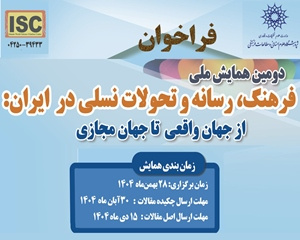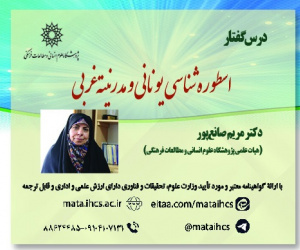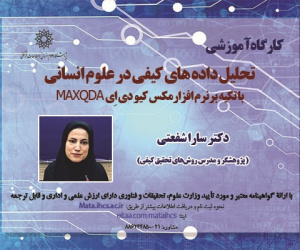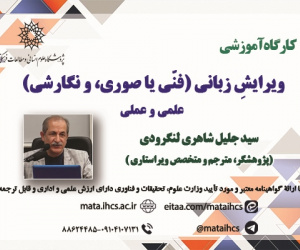تحلیل سبک شناختی مجلسِ نقاشی شیخ صنعان و دختر ترسا در تالار مسقف تکیه هفت تنان شیراز (مقاله علمی وزارت علوم)
درجه علمی: نشریه علمی (وزارت علوم)
آرشیو
چکیده
داستان شیخ صنعان و دختر ترسا از موضوعاتی است که بارها دستمایه ی خلق آثار تصویری قرارگرفته و هنرمندان متعددی بدان پرداخته اند. از میان این آثار، مجلس شیخ صنعان و دختر ترسا در تالار مسقف تکیه هفت تنان شیراز، اهمیت خاصی دارد. این اثر به دستور کریم خان زند، با تکنیک نقاشی رنگ و روغن روی گچ اجراشده است. شخصیت های متعددی در این اثر حضور دارند؛ ازجمله دختر ترسا، شیخ صنعان، مریدان وی و سه شخصیت که در داستان حاضر نبوده و هویت مجهول دارند. با توجه به تأثیرگذاری نقاشی غربی بر نقاشی ایران از اواخر دوره صفوی، می توان نقاشی های این بنا را نیز متأثر از آثار غربی دانست که این اثرپذیری مشخصاً در نوع پوشش بعضی افراد دیده می شود. ضروری بود با توجه به مبهم بودن هویت برخی اشخاص در تصویر، در خصوص شناسایی آن ها بررسی صورت گیرد. از پرسش های اساسی مربوط به نقاشی مذکور، می توان اشاره کرد که نحوه برقراری ارتباط میان فرم و محتوا در این نگاره چگونه است؟ تصویر حاضر به کدام بخش از داستانِ منظوم مربوط می شود؟ پژوهش حاضر از حیث هدف، بنیادی بوده و از منظر ماهیت و روش، توصیفی- تحلیلی است. شیوه گردآوری اطلاعات کتابخانه ای و میدانی و روش تجزیه و تحلیل کیفی بوده است. جامعه آماری تحقیق متشکل از مجلس نقاشی «شیخ صنعان و دختر ترسا»، واقع در تکیه هفت تنان شیراز است که به صورت انتخابی بوده و حجم نمونه مساوی با کل جامعه آماری است. نتیجه کاوش ها نشان داد ارتباط میان فرم و محتوا، بیشتر از طریق به کارگیری خصوصیات نقاشی ایرانی، همچنین کاربرد هندسه در تصویر ایجادشده است؛ به علاوه، نقاشی حاضر، مربوط به ابیات چهل وهشت تا صدوشانزده از شعر شیخ صنعان در کتاب منطق الطیر، اثر عطار نیشابوری است که به نخستین لحظات عاشقی شیخ صنعان می پردازد. مشخص شد شخصیت کتاب به دست در نقاشی شخصیتی که کتاب در دست دارد، مرید صادق شیخ نیست و البته جنسیت شخصی که سمت چپ و بالای نگاره در کنار دختر ترسا ایستاده، مذکر است.Stylistic analysis of the painting of Sheikh Sanan and Dokhtar tarsa in the Haft Tanan roofed hall of Shiraz
The story of Sheikh Sanan and Dokhtar Tarsa is one of the topics that have been used many times to create visual works, and many artists have worked with it. Among these works, the painting of Sheikh Sanan and Dokhtar Tarsa in the roofed hall of Haft Tanan Garden in Shiraz is important. This work was executed by order of Karim Khan Zand, with the technique of oil painting on plaster. Many characters are present in this work, including Dokhtar Tarsa, Sheikh Sanan, his disciples, and three characters who were not present in the story, and their identities are unknown. Considering the influence of Western painting on Iranian painting since the end of the Safavid period, the paintings of this building can also be considered influenced by Western works, which can be clearly seen in the clothing style of some people. Considering the ambiguity of the identity of some individuals in the picture, it was necessary to investigate their identification. Among the basic questions related to the mentioned painting, it can be asked: How is the communication between form and content in this painting? Which part of the story of the poem is related to the present image? The current research has taken a fundamental approach to examine the matter and has chosen the descriptive-analytical method to explore the information. The method of data collection in this research was library-based, and the qualitative analyses presented in the text were based on objective and direct observations of the authors. The sample of the research consists of the painting "Sheikh Sanan and Dokhtar Tarsa," located in the Haft Tanan Garden of Shiraz, which is selective and represents the entire sample. The results of the research showed that the relationship between form and content was mostly created through the use of Iranian painting characteristics, as well as the use of geometry in the image. Additionally, the present painting is related to verses 48 to 116 of Sheikh Sanan's poem in the book "Manteq_o_Teir," by Attar of Neishapour, which deals with the first moments of Sheikh Sanan's love. It was found that the character with the book in his hand in the painting is not the faithful disciple of the sheikh, and the gender of the person standing on the left and top of the painting next to Dokhtar Tarsa is male.







